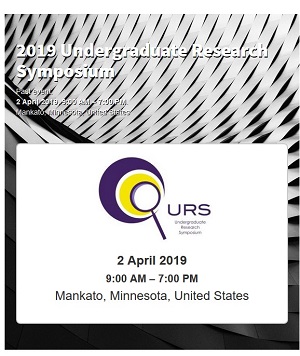Qualitative Comparison of Headspace Analysis and Solid Phase Microextraction Techniques
Location
CSU Ballroom
Start Date
2-4-2019 10:00 AM
End Date
2-4-2019 11:30 AM
Student's Major
Chemistry and Geology
Student's College
Science, Engineering and Technology
Mentor's Name
Daniel Swart
Mentor's Department
Chemistry and Geology
Mentor's College
Science, Engineering and Technology
Second Mentor's Name
Brian Groh
Second Mentor's Department
Chemistry and Geology
Second Mentor's College
Science, Engineering and Technology
Description
The practicality of headspace extraction may be a suitable substitute to the somewhat inaccessible and costly SPME technique. Solid phase microextraction (SPME) is a highly sensitive and valued technique by which a thin organic fiber is inserted into a vial containing a heated solid substance to collect and preconcentrate a small amount of vaporized substance for analysis in a gas chromatography - mass spectrometer (GCMS) instrument. This method, however, can be vulnerable to a phenomenon called displacement, in which larger molecules are preferentially absorbed over smaller ones. Headspace, on the other hand, refers to the gas phase above the heated sample, which can be sampled directly by the syringe present in a GCMS instrument. Since this method doesn't allow for any period of sample preconcentration, it's not as sensitive, but also doesn't allow for any bias in sampling. Samples studied included scented incense grounds and ground coriander seeds, chosen for their strong aroma and therefore propensity to vaporize. A variety of experimental conditions were measured in an attempt to enhance the output of the headspace collection method, including heating temperatures and durations and instrument program manipulation. Headspace consistently provided sizable and numerous peaks comparable to SPME and shows promise being an adequate alternative for non-quantitative work or undergraduate teaching.
Qualitative Comparison of Headspace Analysis and Solid Phase Microextraction Techniques
CSU Ballroom
The practicality of headspace extraction may be a suitable substitute to the somewhat inaccessible and costly SPME technique. Solid phase microextraction (SPME) is a highly sensitive and valued technique by which a thin organic fiber is inserted into a vial containing a heated solid substance to collect and preconcentrate a small amount of vaporized substance for analysis in a gas chromatography - mass spectrometer (GCMS) instrument. This method, however, can be vulnerable to a phenomenon called displacement, in which larger molecules are preferentially absorbed over smaller ones. Headspace, on the other hand, refers to the gas phase above the heated sample, which can be sampled directly by the syringe present in a GCMS instrument. Since this method doesn't allow for any period of sample preconcentration, it's not as sensitive, but also doesn't allow for any bias in sampling. Samples studied included scented incense grounds and ground coriander seeds, chosen for their strong aroma and therefore propensity to vaporize. A variety of experimental conditions were measured in an attempt to enhance the output of the headspace collection method, including heating temperatures and durations and instrument program manipulation. Headspace consistently provided sizable and numerous peaks comparable to SPME and shows promise being an adequate alternative for non-quantitative work or undergraduate teaching.
Recommended Citation
Hagen, Allyssa. "Qualitative Comparison of Headspace Analysis and Solid Phase Microextraction Techniques." Undergraduate Research Symposium, Mankato, MN, April 2, 2019.
https://cornerstone.lib.mnsu.edu/urs/2019/poster-session-A/3



